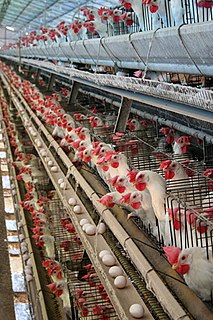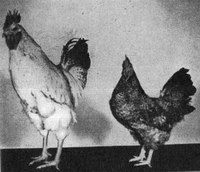Related Research Articles

Poultry are domesticated birds kept by humans for their eggs, their meat or their feathers. These birds are most typically members of the superorder Galloanserae (fowl), especially the order Galliformes. The term also includes birds that are killed for their meat, such as the young of pigeons but does not include similar wild birds hunted for sport or food and known as game. The word "poultry" comes from the French/Norman word poule, itself derived from the Latin word pullus, which means small animal.

The chicken is a domesticated subspecies of the red junglefowl originally from Southeastern Asia. Rooster or cock is a term for an adult male bird, and a younger male may be called a cockerel. A male that has been castrated is a capon. An adult female bird is called a hen and a sexually immature female is called a pullet.

The ileum is the final section of the small intestine in most higher vertebrates, including mammals, reptiles, and birds. In fish, the divisions of the small intestine are not as clear and the terms posterior intestine or distal intestine may be used instead of ileum. Its main function is to absorb vitamin B12, bile salts, and whatever products of digestion that were not absorbed by the jejunum.

The jejunum is the second part of the small intestine in humans and most higher vertebrates, including mammals, reptiles, and birds. Its lining is specialised for the absorption by enterocytes of small nutrient molecules which have been previously digested by enzymes in the duodenum.

Among animals which produce eggs, the yolk is the nutrient-bearing portion of the egg whose primary function is to supply food for the development of the embryo. Some types of egg contain no yolk, for example because they are laid in situations where the food supply is sufficient or because the embryo develops in the parent's body, which supplies the food, usually through a placenta. Reproductive systems in which the mother's body supplies the embryo directly are said to be matrotrophic; those in which the embryo is supplied by yolk are said to be lecithotrophic. In many species, such as all birds, and most reptiles and insects, the yolk takes the form of a special storage organ constructed in the reproductive tract of the mother. In many other animals, especially very small species such as some fish and invertebrates, the yolk material is not in a special organ, but inside the egg cell (ovum).

A hatchery is a facility where eggs are hatched under artificial conditions, especially those of fish, poultry or even turtles. It may be used for ex-situ conservation purposes, i.e. to breed rare or endangered species under controlled conditions; alternatively, it may be for economic reasons.

Chick culling or unwanted chick killing is the process of separating and killing unwanted chicks for which the intensive animal farming industry has no use. It occurs in all industrialised egg production, whether free range, organic, or battery cage. Worldwide, around 7 billion male chicks are culled each year in the egg industry. Because male chickens do not lay eggs and only those in breeding programmes are required to fertilise eggs, they are considered redundant to the egg-laying industry and are usually killed shortly after being sexed, which occurs just days after they are conceived or after they hatch. Some methods of culling that do not involve anaesthetics include: cervical dislocation, asphyxiation by carbon dioxide, and maceration using a high-speed grinder. Maceration is the primary method in the United States.
Natural growth promoters (NGPs) are feed additives for farm animals.

A gapeworm, also known as a red worm and forked worm, is a parasitic nematode worm that infects the tracheas of certain birds. The resulting disease, known as "gape" or "the gapes", occurs when the worms clog and obstruct the airway. The worms are also known as "red worms" or "forked worms" due to their red color and the permanent procreative conjunction of males and females. Gapeworms are common in young, domesticated chickens and turkeys.

Poultry farming is the form of animal husbandry which raises domesticated birds such as chickens, ducks, turkeys and geese to produce meat or eggs for food. It has originated from the agricultural era. Poultry – mostly chickens – are farmed in great numbers. More than 60 billion chickens are killed for consumption annually. Chickens raised for eggs are known as layers, while chickens raised for meat are called broilers.

Eggs are laid by female animals of many different species, including birds, reptiles, amphibians, a few mammals, and fish, and many of these have been eaten by humans for thousands of years. Bird and reptile eggs consist of a protective eggshell, albumen, and vitellus, contained within various thin membranes. The most commonly consumed eggs are chicken eggs. Other poultry eggs including those of duck and quail also are eaten. Fish eggs are called roe and caviar.
Nicarbazin is a coccidiostat used on meat chickens. It is also used as a contraceptive for population control of Canada geese and feral pigeons.

Poultry farming is a part of the United States's agricultural economy.
Keeping chickens is becoming increasingly popular in urban and suburban areas. The reasons for keeping chickens are as pets, for eggs, for meat, or for eating pests. Some people will sell the eggs for side income.
Avian orthoreovirus, also known as avian reovirus, is an orthoreovirus from the Reoviridae family. Infection causes arthritis and tenosynovitis in poultry. It can also cause respiratory disease.

In poultry standards, solid white is coloration of plumage in chickens characterized by a uniform pure white color across all feathers, which is not generally associated with depigmentation in any other part of the body.

Dwarfism in chickens is an inherited condition found in chickens consisting of a significant delayed growth, resulting in adult individuals with a distinctive small size in comparison with normal specimens of the same breed or population.
The avian immune system is the system of biological structures and cellular processes that protects birds from disease.

The broiler industry is the process by which broiler chickens are reared and prepared for meat consumption. Worldwide, in 2005 production was 71,851,000 tonnes. From 1985 to 2005, the broiler industry grew by 158%.

Feed manufacturing refers to the process of producing animal feed from raw agricultural products. Fodder produced by manufacturing is formulated to meet specific animal nutrition requirements for different species of animals at different life stages. According to the American Feed Industry Association (AFIA), there are four basic steps:
- Receive raw ingredients: Feed mills receive raw ingredients from suppliers. Upon arrival, the ingredients are weighed, tested and analyzed for various nutrients and to ensure their quality and safety.
- Create a formula: Nutritionists work side-by-side with scientists to formulate nutritionally sound and balanced diets for livestock, poultry, aquaculture and pets. This is a complex process, as every species has different nutritional requirements.
- Mix ingredients: Once the formula is determined, the mill mixes the ingredients to create a finished product.
- Package and label: Manufacturers determine the best way to ship the product. If it is prepared for retail, it will be “bagged and tagged,” or placed into a bag with a label that includes the product’s purpose, ingredients and instructions. If the product is prepared for commercial use, it will be shipped in bulk.
References
- 1 2 Noy, Y., Z. Uni, and D. Sklan. 1996. Routes of yolk utilization in the newly-hatched chick. Br. Poult. Sci. 37: 987-996.
- 1 2 Maiorka, A., E. Santin, F. Dahlke, I. C. Boleli, R. L. Furlan, and M. Macari. 2003. J. Appl. Poult. Res. 12: 483-492.
- 1 2 Geyra, A., Z. Uni, and D. Sklan. 2001. The effect of fasting at different ages on growth and tissue dynamics in the small intestine of the young chick. Br. J. Nutr. 86: 53-61.
- 1 2 Dibner, J. J., C. D. Knight, M. L. Kitchell, C. A. Atwell, A. C. Downs, and F. J. Ivey. 1998. Early feeding and development of the immune system in neonatal poultry. J. Appl. Poultry Res. 7: 425-436.
- ↑ Larsson, A., R. M. Balow, T. L. Lindahl, and P. O. Forsberg. 1993. Chicken antibodies: Taking advantage of evolution – A review. Poult. Sci. 72: 1807-1812.
- ↑ Moss, F. P., R. A. Sommonds, and H. W. McNary. 1964. The growth and composition of skeletal muscle in the chicken. 2. The relationship between muscle weight and the number of nuclei. Poult. Sci. 43: 283-290.
- ↑ Halevy, O. A. Geyra, M. Barak, Z. Uni, and D. Sklan. 2000. Early posthatch starvation decreases satellite cell proliferation and skeletal muscle growth in chicks. J. Nutr. 130: 858-864.
- ↑ Noy, Y., and D. Sklan. 1999. Different types of early feeding and performance in chicks and poults. J. Appl. Poultry Res. 8: 16-24.